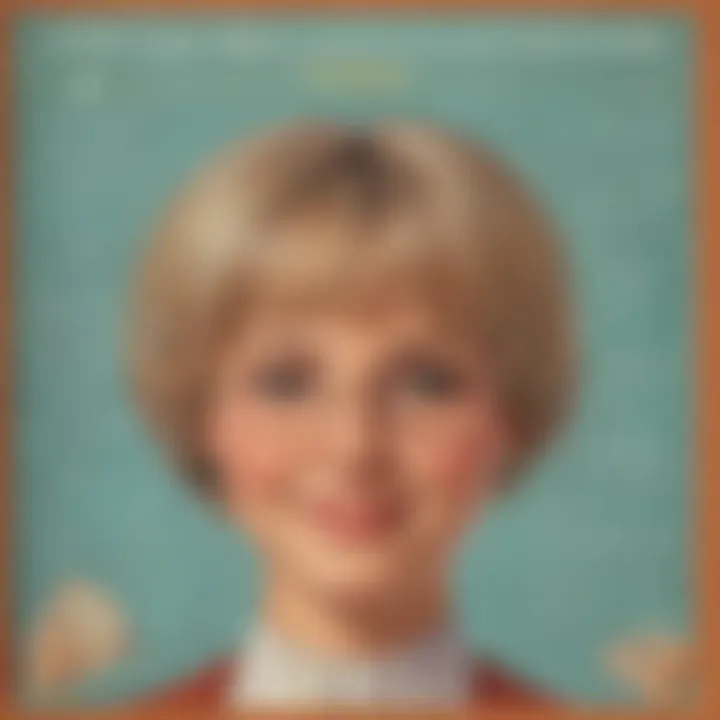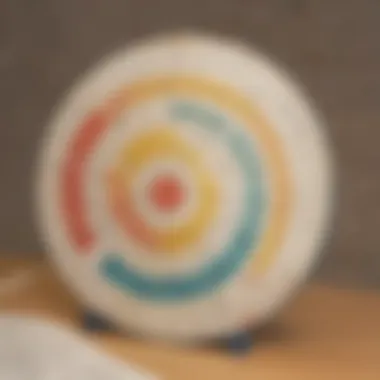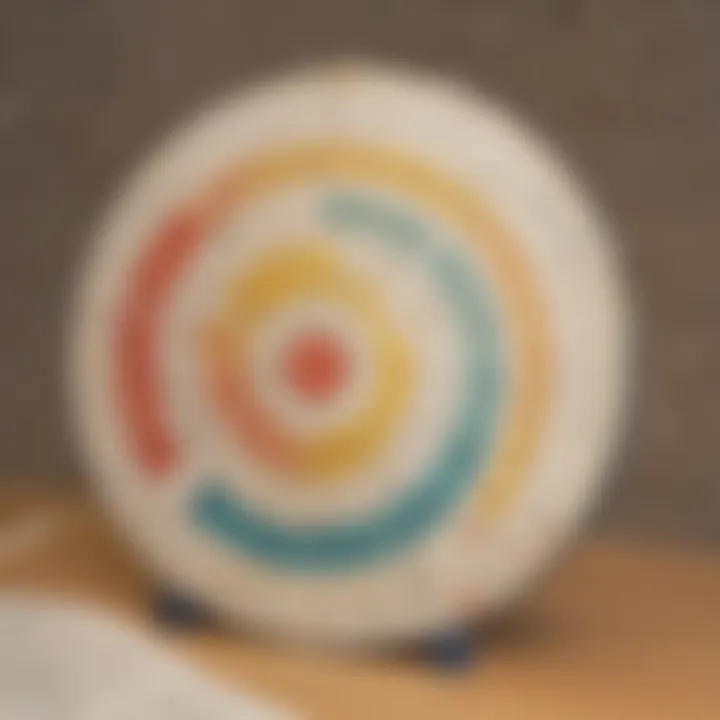Understanding Tenths and Hundredths in Depth


Intro
Understanding the concepts of tenths and hundredths goes beyond mere numbers. These foundational elements of the decimal system play a vital role in mathematics and everyday life. Whether counting money, measuring distances, or engaging in basic operations, a firm grasp of tenths and hundredths is essential. For young learners, these concepts can be especially challenging, making effective teaching methods crucial. In this guide, we will delve into these crucial topics, ensuring clarity and accessibility for elementary-aged children, parents, and caregivers.
Creative Activities
Engaging children through creative activities can enhance their understanding of tenths and hundredths. Here are some crafts and activities that can effectively illustrate these numerical concepts.
Craft Ideas
- Decimal Number Line: Create a large number line using materials like string or paper. Children can physically place tenths and hundredths along the line, helping them visualize their position relative to whole numbers.
- Money Making: Use play money to demonstrate tenths and hundredths, like coins and bills. Encourage kids to represent 10 cents as one-tenth and one cent as one-hundredth.
Step-by-Step Guides
- Decimal Number Line Activity:
- Play Money Activity:
- Materials: String, sticky notes, a marker.
- Instructions:
- Stretch the string across a wall or table.
- Mark intervals for whole numbers.
- Use sticky notes to represent tenths and hundredths.
- Have children place the notes in the correct order.
- Materials: Play money in various denominations.
- Instructions:
- Introduce the coins, explaining each value.
- Ask kids to group coins to make a total of 10 cents, illustrating a tenth, and 1 cent, illustrating a hundredth.
Educational Value
These activities not only engage children but also provide visual and tactile learning experiences. They make abstract concepts more concrete, fostering better retention and understanding. Children who learn through play often find math more approachable and enjoyable.
Fun Quizzes
Quizzes offer a dynamic way to assess children’s understanding of tenths and hundredths. They can reinforce the knowledge gained through creative activities.
Quiz Topics
- Understanding Decimal Place Values: Tenths and Hundredths.
- Real-life Applications: Where Do We See Tenths and Hundredths?
- Problem Solving with Decimals.
Question Types
Quizzes can consist of various question types, such as:
- Multiple Choice: Select the correct answer.
- True or False: Determine the accuracy of a statement.
- Fill in the Blanks: Complete the sentence with appropriate terms.
Quizzes not only test understanding but also encourage children to think critically about the material they have learned.
Knowledge Reinforcement
Administering fun quizzes helps to consolidate knowledge. They serve not only as a learning tool but also as a motivational approach, making kids eager to show what they know. Doing quizzes regularly can highlight areas that need more focus, guiding learning paths effectively.
Fact-Based Articles
Fact-based articles enrich comprehension by presenting information in a structured and engaging manner.
Topics
Articles can cover:
- Detailed exploration of decimal fractions.
- Historical background of the decimal system.
- Practical applications in everyday life.


Engaging Content
The method of presenting information plays a significant role. Fact-based articles should use clear language, visuals, and examples that relate to children’s everyday experiences. Keeping the content accessible ensures better understanding.
Preface to Decimals
Decimals are a vital part of mathematics. They help us represent numbers that are not whole. Understanding decimals is essential for many everyday tasks. This article focuses on tenths and hundredths as key components of the decimal system.
Defining Decimals
Decimals are numbers that include a decimal point. The decimal point separates the whole number part from the fractional part. For instance, in the number 12.34, the part before the decimal is the whole number (12), and the part after the decimal represents fractions (34). Each position after the decimal has a specific value.
Decimals are based on the powers of ten. The first position after the decimal represents tenths, the second represents hundredths, and so on. These positions determine the value of a number. Therefore, knowing how decimals work is crucial for accurate mathematics.
The Importance of Understanding Tenths and Hundredths
Understanding tenths and hundredths is very important. These two decimal places represent commonly used fractions. For example, in real life, prices often end in tenths or hundredths. A price of $5.99 shows both tenths (9) and hundredths (9).
"Knowledge of tenths and hundredths helps in better financial literacy."
This knowledge affects shopping, cooking, and measuring things. It gives clarity when working with money amounts. Without this understanding, tasks may become confusing, leading to errors.
Moreover, being confident in these concepts helps in solving problems involving measurement and data interpretation. Therefore, a solid grasp of tenths and hundredths is not only beneficial in school but also essential for adult life.
The Structure of the Decimal System
The structure of the decimal system is fundamental to understanding tenths and hundredths. It is a base-10 system that simplifies the way we write and express numbers. This structure helps learners make sense of numbers and how to represent them in various contexts. The importance of place value in decimals cannot be understated, as each position in a number reflects a different power of ten.
Place Value in Decimals
Place value forms the backbone of the decimal system. Each digit in a number has a specific value based on its position. For instance, in the number 4.57, the digit 4 is in the units place, 5 is in the tenths place, and 7 is in the hundredths place. This system allows for a clear understanding of how numbers are constructed and interpreted.
Understanding place value enables students to grasp the significance of each digit in a decimal number. This knowledge serves as a stepping stone for more complex arithmetic operations. Therefore, a solid foundation in place value is essential for developing mathematical proficiency.
Understanding Tenths
Definition of Tenths
Tenths refer to the first place to the right of the decimal point. In any decimal number, this position indicates a fraction of ten. For instance, in the number 0.3, 3 represents three tenths. This understanding is crucial, as it directly links to the concept of fractions and percentages, making it easier for students to visualize. The key characteristic of tenths is that they break down whole numbers into manageable parts. This is a beneficial aspect because it helps learners and practical applications in everyday math.
Examples of Tenths in Real Life
Tenths are prevalent in many real-life scenarios, which help to solidify understanding. For example, when measuring distances, one might encounter figures like 1.2 kilometers, where the 2 signifies two tenths of a kilometer. Another common instance occurs in financial transactions, where costs such as 5.4 dollars can be seen, indicating four tenths of a dollar. These examples illustrate the practicality of tenths and their influence on daily calculations.
Understanding Hundredths
Definition of Hundredths
Hundredths are located two positions to the right of the decimal point. This represents a fraction of one hundred. In the number 0.25, the 2 is in the tenths place, and the 5 is in the hundredths place. The defining characteristic of hundredths is their role in expressing precision in measurements and calculations, which is why they are a popular topic within the structure of decimal representation. The unique aspect that sets hundredths apart is their ability to convey more accurate financial information, such as in currency, where precision is vital.
Examples of Hundredths in Real Life
Hundredths appear frequently in practical situations. An example includes pricing in stores, such as $3.99, where the 99 reflects ninety-nine hundredths of a dollar. Another example is in statistics, where percentages often require the use of hundredths to provide accuracy.
Understanding how hundredths function within the decimal system enriches the learner's experience. It helps clarify how minor variations in values can have significant implications in everyday tasks.
Comparative Analysis of Tenths and Hundredths


The comparative analysis of tenths and hundredths provides a clear understanding of how these two components function within the decimal system. By examining their differences and similarities, we can illustrate their utility in mathematical operations and real-life applications. Recognizing these distinctions is crucial for students, parents, and educators as it lays the foundation for more complex numerical concepts later on. Understanding these comparative elements enhances comprehension and encourages proper usage in various contexts.
Visualizing Tenths vs. Hundredths
Visual representation plays a vital role in grasping the concepts of tenths and hundredths. When learners can see how numbers are divided, it simplifies the learning process. Tenths can be visualized as a whole divided into ten equal parts, where each part equals 0.1. On the other hand, hundredths represent a whole divided into one hundred equal pieces, with each piece equaling 0.01.
For instance, consider a pie chart:
- A pie chart divided into 10 equal slices represents tenths. Each slice corresponds to 0.1 of the total pie.
- A pie chart divided into 100 equal slices serves to visualize hundredths. Each slice corresponds to 0.01.
This clear distinction can help solidify the learners' understanding and enable them to conceptualize decimal values effectively.
Mathematical Relationships
Understanding the mathematical relationships between tenths and hundredths is essential. Their interactions form a crucial part of arithmetic operations involving decimals. This knowledge is foundational when engaging younger students with fundamental math skills.
Conversions between Tenths and Hundredths
Conversions between tenths and hundredths are simple yet critical transactions in the decimal system. To convert from tenths to hundredths, multiply the value by 10. Conversely, to go from hundredths to tenths, divide by 10. For example, the decimal 0.2 (which is two tenths) equates to 20 hundredths, or 0.20.
This aspect of conversions is popular because it encourages learners to think critically about decimal values. It allows them to move fluidly between different representations of numbers. A unique feature of this conversion is its straightforwardness, enabling students, even those new to decimals, to grasp the relationship easily. Understanding these conversions is important as it expands students' numerical capabilities and prepares them for advanced concepts.
Adding and Subtracting Tenths and Hundredths
Adding and subtracting tenths and hundredths presents an opportunity for learners to engage actively with decimals. It is a fundamental aspect of arithmetic that reinforces basic problem-solving skills. The key characteristic of adding tenths, such as 0.3 and 0.4, is ensuring aligned decimal points. This practice clarifies the addition process.
When subtracting, the same alignment should be maintained. For example, subtracting 0.25 (two hundred fifty hundredths) from 0.55 (five hundred fifty hundredths) directly benefits from a well-structured approach.
This method is beneficial for building confidence in dealing with decimals. Moreover, it encourages practice on numerical operations, fostering better retention and understanding for young learners. Through consistent practice of adding and subtracting tenths and hundredths, students become adept in handling more complex mathematical scenarios.
Teaching Methods for Tenths and Hundredths
Teaching methods surrounding tenths and hundredths are crucial in helping young learners grasp these concepts. Many children struggle with the abstract nature of decimals, especially when they first encounter them in classroom settings. By using effective teaching strategies, educators can create a solid foundation for students. This section will focus on innovative methods and practices that can enhance learning and understanding of tenths and hundredths.
Effective Strategies for Educators
Educators can utilize several strategies to effectively teach tenths and hundredths. One primary method involves using familiar real-life examples to illustrate these concepts. For instance, talking about money can significantly help children understand tenths and hundredths. Since dollar amounts often contain cents, students can easily visualize how a dollar is divided into tenths and hundredths.
Additionally, using visual aids, like number lines and decimal grids, can help students see decimal values in a tangible way. Showing how tenths and hundredths fit into the broader decimal system can clear confusion and reinforce concepts. Engaging students through discussions about how these fractions appear in everyday scenarios makes learning relevant and meaningful.
Interactive Activities for Students
Games Involving Tenths and Hundredths
Games can be a beneficial method for encouraging students to learn about tenths and hundredths. They create a fun, engaging atmosphere where children can explore decimal concepts without pressure. One popular game involves using a bingo card format where students must match decimal fractions with their corresponding visual representations. This game requires active participation and helps reinforce understanding through practice.
A key characteristic of these games is their ability to facilitate collaborative learning. Students work together, discuss choices, and solve conflicts in answers, simulating real-world interactions involving mathematics. However, it's important to maintain balance so that competition does not overshadow the educational goal.
Hands-On Learning Tools
Hands-on learning tools offer a tactile approach to understanding tenths and hundredths. Tools such as decimal blocks can be especially useful. These blocks can visually represent decimal places, allowing students to physically manipulate the pieces to see how tenths and hundredths relate to whole numbers.
The key characteristic of hands-on tools is their ability to bridge theory and application effectively. They can engage students who may struggle in a traditional learning environment. Students can experiment and discover principles independently. However, teachers should supervise to ensure that students remain focused on learning rather than just playing.
Important Note: Using a combination of these methods may yield the best results. Engaging in both interactive games and hands-on activities fosters a deeper understanding of decimals.
In summary, innovative teaching methods for tenths and hundredths are vital for young learners. By applying effective strategies, utilizing interactive activities, and offering hands-on tools, educators can enhance the learning experience. This comprehensive approach ultimately leads to a more profound understanding of decimals.


Applications in Everyday Life
The concepts of tenths and hundredths play a vital role in our daily life. Understanding these decimal values is essential for making informed decisions, especially in contexts like shopping and measurements. When handled correctly, these decimals can enhance both efficiency and accuracy in various activities. This section will delve into how tenths and hundredths apply in everyday scenarios that many encounter regularly.
Using Tenths and Hundredths in Shopping
When individuals shop, knowing how to read prices accurately is fundamental. Prices often include tenths and hundredths, affecting final costs. For example, a shirt may be priced at $19.99. The decimal is not only for show; it represents a fraction of a dollar that is an essential part of the total price.
In shopping contexts, understanding tenths and hundredths helps consumers make better choices. Here are a few key points to consider:
- Discounts and Sales: When items go on sale, discounts are frequently expressed in tenths and hundredths. For instance, a 20% discount on a $25 jacket means calculating $5 off. Recognizing how to quickly compute this encourages smart shopping.
- Tax Calculations: Sales tax can also involve tenths and hundredths. If a purchase costs $15.50, and the tax rate is 8%, one must calculate $15.50 x 0.08, which equals $1.24. The total amount paid is $16.74. Proper understanding helps shoppers estimate costs better.
- Budgeting: Keeping track of finances often involves decimal numbers. Knowing how to add or subtract tenths and hundredths ensures an accurate budget, helping people plan their spending effectively.
In this way, tenths and hundredths greatly enhance a shopper’s ability to act wisely with money.
Tenths and Hundredths in Measurements
Measurements are another area where tenths and hundredths are quite significant. When measuring objects, calculations in tenths and hundredths provide precision, which is necessary for tasks ranging from cooking to construction.
Consider these aspects:
- Cooking: In many recipes, ingredients are measured in grams or milliliters, often requiring precision to one or two decimal places. For example, one may need 1.5 liters of water or 250.75 grams of flour, where the tenths and hundredths indicate accuracy that affects the final product.
- Construction: In carpentry, precise measurements are crucial. A piece of wood cut to 2.5 meters can fit perfectly in a designated space. Miscalculating this by even a tenths can lead to material waste and project delays.
- Science Experiments: Experiments require accurate measurements. For instance, when measuring the mass of a substance, results like 0.45 grams provide critical data that scientists rely on to maintain accuracy in their findings.
Thus, the application of tenths and hundredths in measurements ensures precision and efficiency in everyday tasks, facilitating successful completion of various activities.
Common Misunderstandings
Understanding tenths and hundredths can be straightforward, yet many students struggle with these concepts due to common misconceptions. It's essential to address these misunderstandings to ensure a firm grasp of decimal fundamentals. When students misinterpret how decimal place values work, it complicates their grasp of more advanced math concepts later. Misconceptions can stem from teaching methods, informal explanations at home, or even mistakes in educational materials.
Misconceptions About Decimal Place Values
A significant misconception revolves around the idea that place values in decimals behave like whole numbers. Some students may think that just as a number can be rounded up or down easily, decimals can be treated in the same way without regard for their place value. For instance, they might confuse 0.1 and 0.01 as being equal, when in fact, 0.1 is ten times larger than 0.01. The structure of decimals requires understanding that each place reflects a fraction of ten.
A few specific points to consider include:
- Decimal positions are not interchangeable. Each position has a distinct value depending on its distance from the decimal point.
- Underestimating the importance of tenths versus hundredths. Children need to see that tenths and hundredths are used differently in practical scenarios.
- Misinterpretation of rounding rules. Some students might believe that rounding to the nearest whole number applies directly to decimals without understanding the underlying significance of the decimal itself.
It’s important for educators and parents to clarify these misconceptions using tools like number lines or visual aids to show decimal placement more clearly.
Overcoming Challenges with Tenths and Hundredths
To help students overcome their challenges with tenths and hundredths, targeted strategies can be effective. Individual attention is necessary, as understanding varies among students. A few effective methods include:
- Practical demonstrations. Using money or measuring devices can help children relate decimal concepts to their everyday life. Using ten dimes versus one dollar can demonstrate tenths versus hundredths clearly.
- Visual aids. Charts and fraction strips can enhance comprehension. They allow students to physically see the relationship between tenths and hundredths alongside the corresponding fractions.
- Group activities. Collaborating in pairs or small groups can encourage students to explain concepts to each other, reinforcing their understanding through discussion and peer teaching.
"Understanding decimal place value is a stepping stone to mastering more complex mathematical concepts, making it crucial to clear up misconceptions early on."
In bridging these common misunderstandings, students can develop a more robust mathematical foundation. Through active learning and engaging educational activities, grasping tenths and hundredths becomes much more achievable. This leads to greater confidence in their mathematical capabilities, which beneficially impacts their overall academic performance.
Culmination
Understanding tenths and hundredths is essential for grasping the broader concepts of decimals. These two parts of the decimal system serve as foundations for mathematical understanding. They are prevalent in everyday activities like shopping and measurement. In this article, we have explored their significance, teaching methods, and common misunderstandings.
Recapping the Importance of Tenths and Hundredths
Tenths and hundredths are critical in various calculations. Tenths represent one part of ten, while hundredths represent one part of one hundred. Recognizing their importance helps students understand how decimals operate. Furthermore, these concepts lay the groundwork for advanced mathematical topics. For example, comprehending these decimal fractions aids students in grasping percentages and ratios more effectively.
In daily life, people encounter tenths and hundredths often. Consider when checking prices at a grocery store. A price tag of $3.49 includes tenths and hundredths. Recognizing that $3.49 is made up of three dollars, four tenths of a dollar, and nine hundredths helps clarify the cost.
"Understanding tenths and hundredths is foundational for all future math skills, making it a necessary topic in elementary education."
Encouraging Further Exploration of Decimal Concepts
Encouraging children to explore tenths and hundredths fosters curiosity and deeper understanding. Parents can create engaging activities where children measure ingredients when cooking or baking. This practical approach allows kids to see decimals in action. For instance, measuring 0.5 liters of water introduces tenths clearly.
Additionally, various resources can further clarify decimals. Online platforms like Wikipedia or Britannica provide in-depth articles on these topics. These platforms can be beneficial for parents and educators looking to enhance their teaching strategies.







